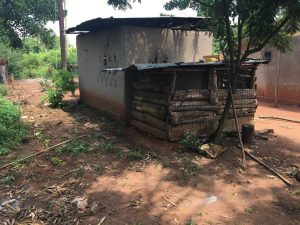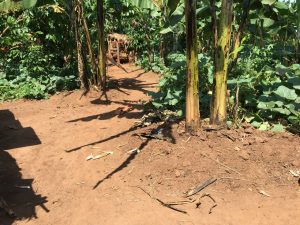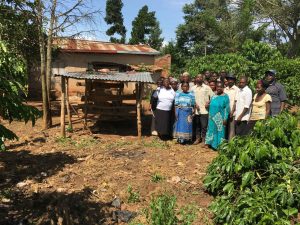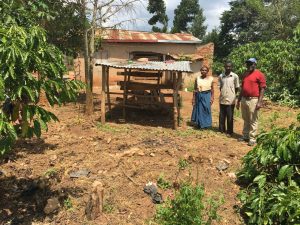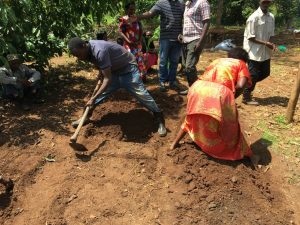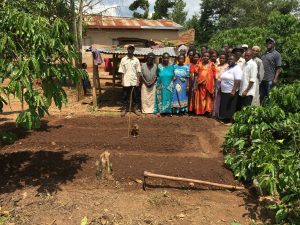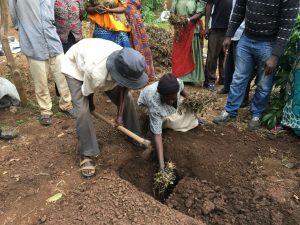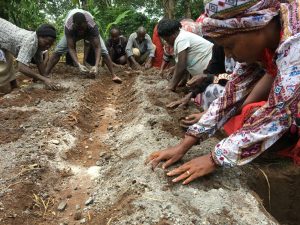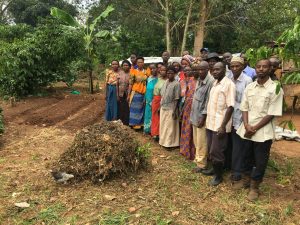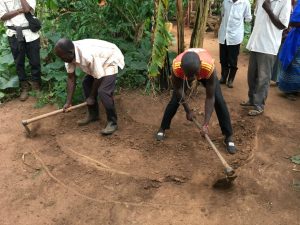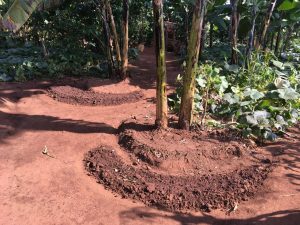This project is made possible through the partnership of WATER CHARITY and the NATIONAL PEACE CORPS ASSOCIATION. ![]()
This project has been completed. To read about the conclusion, CLICK HERE.
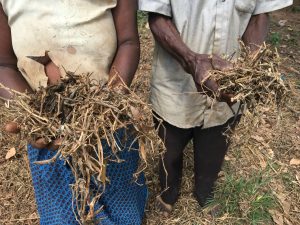 The seventh training of our Permagarden Training Initiative – Worldwide will take place in June 2018. Peter Jensen will train community volunteers with his Terra Firma Permagardens for Empowerment and Resilience course. Here is an outline of what will be accomplished in the training.
The seventh training of our Permagarden Training Initiative – Worldwide will take place in June 2018. Peter Jensen will train community volunteers with his Terra Firma Permagardens for Empowerment and Resilience course. Here is an outline of what will be accomplished in the training.
What:
To provide a complete, hands-on, Four Day Terra Firma Permagarden Creation and Outreach Training
Trainer:
Peter Jensen, RPCV (Haiti, 1985-87), Agroecology and Permagarden Training Specialist. Peter will be working with Gerald Nkusi, ALCDI Uganda, as a training assistant and co-facilitator.
Host and Local Direction:
Patrick Wasswa, Executive Director, Community Health Initiative and Livelihood Development (CHILD). CHILD is a Ugandan nonprofit with a mission “to explore, discover and harness opportunities to transform life chances of the underserved and hard-to-reach.”, working specifically “to address the socio-economic challenges faced by women and girls in Nakaseke District.”
Where:
Nakaseke District, Uganda
Who:
25 community outreach volunteers of CHILD.
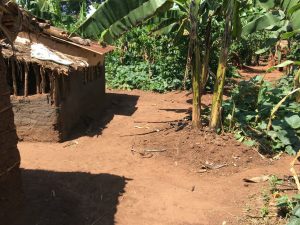 Summary:
Summary:
25 community volunteers will be trained over 4 days on how to create and teach the standard 3x3m Permagarden as well as the new innovation, the Terra Firma Keyhole. The keyhole is a small-scale version of the Perma garden which is particularly suited for the corners of outdoor kitchens and those families with extremely small land availability. The keyhole still teaches all the Terra Firma Agroecological lessons of resource assessment, carbon capture, water management, and bio-intensive soil health management and intensive plant spacing as taught in the standard Permagarden.
CHILD staff will provide monthly follow-up site visits with all trained individuals and encourage the continuing outreach of this small, doable action-oriented, nutrition security and water management approach.
The step-by-step Terra Firma Method will be used throughout to guide learners and future trainers on how to make the most suitable all-organic, water-conserving, nutrition-focused, home garden for this particular climate and culture.
Terra Firma guides the learner to make the most informed agroecological-appropriate garden but can also be used intersectoral in public health, youth development and small enterprise development situations as well.
All actions within the workshop will foster independence rather than dependence upon outsiders to continue. The Terra Firma method uses only the tools, plants and soil amendments that are already locally accessible to targeted beneficiaries, namely rural poor farmers, mothers, and children, enabling further adoption within the local community following training by these soon-to-be trainers.
Follow-up within 3 months of training will be reported to show onward adoption of this simple yet empowering methodology. 60 home gardens are anticipated within this first period, benefiting 7 people per garden, for an expected total of over 400 persons. A full year later this figure will be expected to be near 200 gardens, resulting in outreach to over 1,500.
Conclusion of CHILD Permagarden Training – Uganda
This project has been completed under the direction of Peter Jensen, Agroecology and Permagarden Training Specialist. The training was hosted and locally organized by Patrick Wasswa, Executive Director, Community Health Initiative and Livelihood Development (CHILD). Gerald Nkusi, ALCDI Uganda, worked as a training assistant and co-facilitator. To read about the start of the project, CLICK HERE.
Peter reports:
These 25 men and women were highly engaged and excited to learn how to control and save their rainwater. Over just 3 days they learned and practiced many new skills: how to assess and creatively capture local organic materials; how to protect their landscape from both the maximum and the minimum rains; how to easily make high quality compost for moisture retention and soil health; how to plant and manage a bio-intensive, diverse vegetable garden; and how to see this garden as a true “water holding tank” to provide nutritious food all year round.
Climate Smart actions allow daily nutrition focus that will effectively provide quality food for their families.
All hands were raised when we asked who planned to go home to create their own gardens and teach others starting next week! Patrick Wasswa and his small team will provide follow-up encouragement and feedback to me over the coming three months in the build up to the next rainy season.
Group Before: These local community volunteers supported by CHILD (community Health Initiative and Livelihood Development) in Nakaseke, Uganda have just completed a local resource assessment and determined that this is the best place to make a water capture garden. This small shed roof will provide over 6000 liters of rainwater alone.
Group After: The fully protected, climate-smart, nutrition focused permagarden ready to receive the rain whenever it decides to fall. The three fingers signify the critical needs to improve the quality of any soil in the world: air, carbon and water.
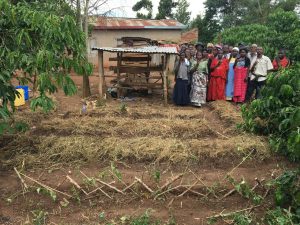
Bed Design: Meter wide garden beds and berms allow for water capture, productive garden crops and easy management.
Single Dug: The complete garden layout for water capture is single dug to determine initial soil quality and to prepare for the water retaining double dig to come the next day.
The Double Dig: The Village Chairman and his wife team up to deeply dig and amend the subsoil of one of the garden beds. This high carbon material will improve soil health and quality as well as help the soil retain larger volumes of rain water.
Topsoil Feeding: Learning the values of local waste materials and how to properly incorporate them throughout the year
Preparing to feed the Subsoil (3135): Local carbon materials are gathered and blended. This is a mixture of dry peanut and bean plants, small sticks and charcoal. This will help the soil retain moisture and will slowly decompose into humus that is vital for soil health.
The Water Tank: The garden bed design is clearly ready to receive and hold the runoff from the many roofs and paths of this family compound.
Keyhole Process: The Terra Firma keyhole is a small adaptation for those who have little land or who are not yet ready to attempt the full size permagarden. The curving swale and berm will catch a small portion of the runoff coming along this path. All 5 Terra Firma action steps are undertaken but in a much smaller space.
Keyhole After: What had been two areas without runoff water control are now fully prepared to receive and hold the runoff. Each of these garden berms will be double dug and amended with carbon while also capturing the runoff and holding it within the subsoil.
The Terra Firma Keyhole can be the real game changer as it leads to early positive attitudes that can quickly turn to further positive actions.
We extend our thanks to Peter for completing this important project.
